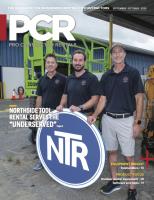Service Tips -- Cut maintenance costs
Take advantage of these four trends to cut operations costs.
by Brian Dzuik
Let’s take a look at a number of trends in North America that are successfully creating a decline in fleet maintenance costs and how fleet managers can take advantage of them.
Using the most up-to-date information from sources such as the INRIX Global Traffic Scorecard, Fleet Management Weekly, and the NAFA’s Fleet Acquisition and Disposal Guide, Lifecycle Cost Analysis, Rastrac, a provider of GPS tracking devices and remote asset tracking systems, can track how fleet managers and owners can identify solutions most applicable to reducing fleet maintenance costs. Here are four ways maintenance automation and fleet tracking can reduce costs:
1) Global Positioning Satellite software reduces expenses
Tracking a rental fleet can be a logistics nightmare when changes in pick-ups, delivery, weather, closing times, freeway access and traffic come up at the worst possible times. Having every vehicle on a GPS mapping system can tell the fleet manager instantly who is where and what is the best solution for unexpected customer needs.
Clients who find a rental center that can get a vehicle to them much quicker than expected will be excited to continue using that rental center’s fleet services for important pick-ups and deliveries. Fleet managers no longer have to send out an additional vehicle if there is a truck with a partial load that was re-directed earlier and is closer to a client in need than an alternative vehicle further away.
Further, GPS mapping can help managers redirect vehicles when there is a traffic problem, freeway bottleneck, or an alternative route that will save fuel, time, and might be safer for a driver. GPS tracking devices have the ability to update every 5 or 10 seconds. North American companies are kept informed of changes in arrival times, availability, and emergencies in almost real-time while vehicles are traveling.
2) Improved fuel efficiency
Fleet managers are preparing for mobile fuel payments and chi-card technologies as a proactive revenue-generating opportunity. Closing the loop on secure fuel processing data tracks spending between the pump and payment processing. This is one of the leading costs now being managed by GPS tracking and helps avoid over-estimating fuel consumption and costs.
During studies on fleet driver’s behavior, company owners and their managers’ eyes were opened on the amount of fuel burned by drivers running their engines to power the air conditioning while sitting in the truck during their hour-long meal breaks.
Scheduling fueling stops with a GPS mapping feature can find the best price, lowest taxes and quickest on-route access, which can provide major savings to companies with larger fleets.
3) Maintenance reduces operations costs
Regular preventative maintenance can prevent heavy repair, damages, and breakdown costs. This reduces breakdown delays and late deliveries. Keeping the fleet in good repair also limits surprises on the road.
Proper inspection of fleet vehicle security devices ensures that cargo is locked up at the dispatch location and delivered untouched and secure at its next rental destination.
A vehicle maintenance program can reduce the number of breakdowns with a preventive maintenance checklist that includes data about parts replacement scheduling, tire rotation and monitoring wear, fluid replacements, minor repairs and other routine maintenance tasks.
These priority monitoring policies also help insurance providers offer better deals for insuring your business and fleet drivers.
4) Keep drivers on task with video
Incidents related to driver behaviors such as idling, speeding, infractions on the road and other poor driving habits leading to unsafe practices and traffic tickets. Monitoring drivers can help reduce these unnecessary expenses and are no longer a drain on operational costs. Fleet owners report a serious reduction in accidents and incidents causing driver delays.
Another benefit of the video monitor is real-time viewing by the logistics coordinator, and first-hand account if there is an accident or incident with your vehicle en route. The first incident data reports are a high-value ROI for legal and back up proof of responsible handling.
Using video recording during shipping is a safe deterrent for would-be criminals who see the difficulty in attempting to steal your secure cargo.
Fleet drivers are aware of the installed security devices and avoid being caught leaving the established route or engaging in unauthorized stops.
In addition to monitoring upfront operating fleet maintenance costs in real time, these secure systems, such as using fleet management software and GPS tracking devices, offers accurate data to the fleet manager. It accurately demonstrates the behind-the-scenes operating costs as well. The more information coming back from the fleet in the field, the better this data can be used to help anticipate cost-saving solutions in all situations.
Brian Dzuik is marketing director at Rastrac, a provider of fleet and operations management solutions across all business verticals regardless of fleet size or asset type. Rastrac tracks more than $1.5 billion worth of assets across the globe. Learn more at www.rastrac.com.
###
This article originally appeared in the November-December 2021 issue of Pro Contractor Rentals magazine. ©2021 Urbain Communications LLC. All rights reserved.










